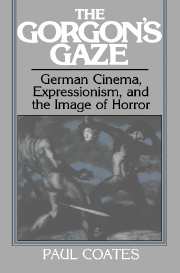Book contents
- Frontmatter
- Contents
- Preface
- Acknowledgments
- Introduction: The uncanny and the gorgon's gaze
- I Silent cinema and expressionism
- II The sleep of reason: Monstrosity and disavowal
- III Memory and repression in recent German cinema
- IV Expressionism in America
- V Elective affinities and family resemblances: For Margarethe von Trotta
- Appendixes
- Notes
- Selected bibliography
- Filmography
- Index
V - Elective affinities and family resemblances: For Margarethe von Trotta
Published online by Cambridge University Press: 21 October 2009
- Frontmatter
- Contents
- Preface
- Acknowledgments
- Introduction: The uncanny and the gorgon's gaze
- I Silent cinema and expressionism
- II The sleep of reason: Monstrosity and disavowal
- III Memory and repression in recent German cinema
- IV Expressionism in America
- V Elective affinities and family resemblances: For Margarethe von Trotta
- Appendixes
- Notes
- Selected bibliography
- Filmography
- Index
Summary
Introduction
In this final chapter, the separate preoccupations of this book converge, filings congregating around a single work: Margarethe von Trotta's Marianne and Juliane (Die bleierne Zeit). Here the horror pervasive in expressionism is sparked by a return of the historical repressed, the resurgence of the German past, as the fearsome images of concentration camps or Grünewald's painting of the crucifixion spawn further images of tortured bodies, the fruit of the terrorist's futile attempt to end terror through further terror. Von Trotta's film, a reworking of the story of Gudrun and Christiane Ensslin, invites comparison with two other films in particular: Bergman's Persona, whose terrifying images (a burning monk, the Warsaw Ghetto photograph) harrow the mind like Grünewald's painting, and which resembles Von Trotta's work in its concern with doubling, splitting, and dead and victimized children; and Straub's Not Reconciled (Nicht versöhnt), a film version of Böll's Billiards at Half-Past Nine, which also considers terrorism as a cry in the echo chamber of the Nazi past, and reflects on how that past is to find a future – that is, children. Where Bergman's Elisabet Vogler is silenced by the world's violence, Von Trotta's Juliane strives to articulate horror.
- Type
- Chapter
- Information
- The Gorgon's GazeGerman Cinema, Expressionism, and the Image of Horror, pp. 193 - 228Publisher: Cambridge University PressPrint publication year: 1991



